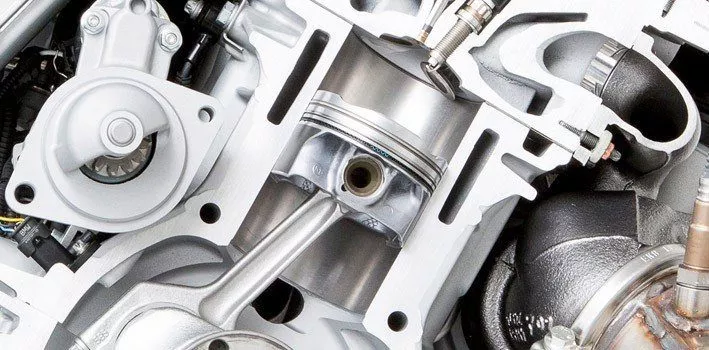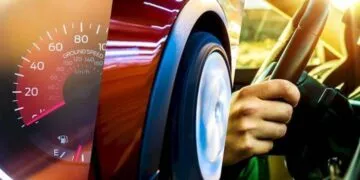The internal combustion engine, or ICE, is a seriously impressive piece of engineering.
It generates motive power by the burning of fuel and air inside the engine to push pistons.
The idea is that when a tiny amount of fuel (like diesel, gasoline or renewable/alternative fuels including natural gas or bio-diesel) is ignited in a small enclosed space, a huge energy release is made which can be harnessed for propulsion.
They can also be used with hybrid electric components to increase fuel economy or hybrid plug-in electric systems to extend the range of these vehicles.
The main types of ICE are the 4-stroke, found in cars, buses, and other modern transport vehicles, and the 2-stroke, found in mopeds and lawn mowers.
Obviously with more than 1 stroke, the timing is vital for it to run efficiently and even at all.
So how do these engines actually work?
The 4-stroke engine

A 4 stroke engine is a multi-cylinder engine, where the cylinders are usually arranged in three ways; inline, V or flat.
The cylinder is the engine core, with the piston moving up and down inside the cylinder to compress a mixture of fuel and air that’s drawn in when it moves down.
When I started out as a mechanic I was always told that to understand how an engine works all you need to know is “suck, squeeze, bang, blow”.
But what does that mean?
Suck
The piston (a metal bar fitted with a ring for a perfect seal) inside a cylinder starts at the top then as the intake valve opens the piston moves down to fill the cylinder full of air and gasoline.
The mix only needs to contain a tiny amount of gasoline compared to air.
Throughout every movement of an engine, the sump supplies oil and ensures proper lubrication.
Squeeze
Then the piston moves back up the cylinder to compress the fuel/air mixture.
Compression makes the mixture much more flammable and the explosion more powerful.
Bang
When the piston reaches the top of its stroke, a spark plug, a device that sparks when an electrical charge is passed through it, sparks to ignite the gasoline.
The gasoline charge in the cylinder literally explodes, producing hot gas that pushes the piston down again.
Blow
Once the piston hits the bottom of its stroke, the exhaust, or outlet, valve opens.
The crankshaft (a device that changes the pistons linear motion into rotational to ensure all the pistons run in sync) pushes the piston back up with the help of a connector rod.
This forces the exhaust gases up the cylinder, out the exhaust valve and down the tailpipe.
The 2-stroke engine

A two-stroke engine in its truest form is very simple both to construct and to operate.
It has only three major moving parts, all of them are also involved in the 4-stroke alternative above; the piston, connecting rod, and crankshaft.
There are however some that are different like a reed valve.
The two-stroke cycle is a bit harder to understand as unlike the 4-stroke engine, certain phases of the cycle occur at the same time, making it difficult to see when one ends and the next starts.
The two stroke engine employs both the crankcase and the cylinder to achieve all the elements of the Otto cycle in only two strokes of the piston.
This type of engine is much lighter, simpler and potentially has a bigger power boost, as it fires every revolution, unlike the 4 stroke which fires every other.
Suck
The fuel/air mixture is drawn into the crankcase by the vacuum that is created during the piston’s upward stroke.
Crankcase Compression
During the downward stroke, the valve is forced closed by crankcase pressure.
The fuel mix is compressed in the crankcase during the stroke.
Exhaust
Toward a stroke’s end, the piston reveals the intake port so the compressed mix in the crankcase can flow around the piston into the main cylinder.
This pushes the exhaust gases out the exhaust port, found on the other side of the cylinder, but this can mean some of the fuel mix is wasted.
Compression
The piston goes back up and compresses the fuel mix.
Whilst this happens, another intake stroke is being carried out beneath it.
Power
When the stroke reaches the top, the spark plug ignites the mix which expands, driving the piston downward, to complete the cycle.
So there we have it you should now be able to explain the internal combustion engine, more specifically the 2 and 4-stroke variations, to anyone with ease.
The ICE revolutionized the world of transport, unlike its external counterparts, the steam train for example, it doesn’t shoot out drastic amount of steam or by-product.
The trouble is that with the ever growing green movement happening today and electrical cars particularly being at the forefront of the automotive mind-set, the ICE will eventually become a thing of the past.
Tesla for example are the main producers of high-end electrical cars with more gismos than you can imagine and with even every day brands like Nissan and Renault releasing these types of vehicle, it really does seem the final bell isn’t far off being tolled for this immense piece of technology, I for one will miss it.
However for now at least, you understand how your car’s engine works and know what happens to that tank of fuel you seem to put in every week.


















